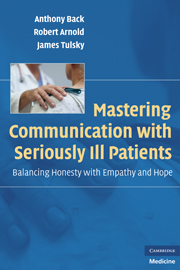Book contents
- Frontmatter
- Contents
- PREFACE
- 1 TAKING YOUR SKILLS TO THE NEXT LEVEL
- 2 GETTING A GOOD START
- 3 TALKING ABOUT SERIOUS NEWS
- 4 DISCUSSING EVIDENCE FOR MAKING TREATMENT DECISIONS
- 5 DISCUSSING PROGNOSIS
- 6 BETWEEN THE BIG EVENTS
- 7 CONDUCTING A FAMILY CONFERENCE
- 8 DEALING WITH CONFLICTS
- 9 TRANSITIONS TO END-OF-LIFE CARE
- 10 TALKING ABOUT DYING
- 11 CULTIVATING YOUR SKILLS
- APPENDIX A THE ROADMAPS IN OUTLINE FORM
- APPENDIX B ACKNOWLEDGMENTS
- INDEX
9 - TRANSITIONS TO END-OF-LIFE CARE
Uncovering the big picture amid fear and failure
Published online by Cambridge University Press: 23 November 2009
- Frontmatter
- Contents
- PREFACE
- 1 TAKING YOUR SKILLS TO THE NEXT LEVEL
- 2 GETTING A GOOD START
- 3 TALKING ABOUT SERIOUS NEWS
- 4 DISCUSSING EVIDENCE FOR MAKING TREATMENT DECISIONS
- 5 DISCUSSING PROGNOSIS
- 6 BETWEEN THE BIG EVENTS
- 7 CONDUCTING A FAMILY CONFERENCE
- 8 DEALING WITH CONFLICTS
- 9 TRANSITIONS TO END-OF-LIFE CARE
- 10 TALKING ABOUT DYING
- 11 CULTIVATING YOUR SKILLS
- APPENDIX A THE ROADMAPS IN OUTLINE FORM
- APPENDIX B ACKNOWLEDGMENTS
- INDEX
Summary
What counts as a transition?
When prolonging life together with an acceptable quality of life no longer seems achievable, we are prompted to change the goals of care. Discussing such a change begins a process of transition that, however necessary, is also very scary. The paradigm for transition conversations is drawn from cancer medicine, when patients have no further anticancer options and stop receiving anticancer therapy. For other serious illnesses, the transitions may be more subtle. For a patient with HIV, the transition might be when antiretroviral meds no longer seem worthwhile. For a patient with heart failure, the transition might be when the patient is bouncing between pulmonary edema and renal insufficiency. In any case, talking about transitions is an uncomfortable moment for patients and clinicians alike. For many patients, making a conscious, explicit decision to stop disease-modifying therapy requires giving up hopes for living longer. For physicians, recommending the discontinuation of disease-modifying therapy often feels like failure.
Any failure is usually the result of overwhelming pathology, but physicians can't help but feel that they have been personal failures. This makes talking about disease progression difficult. As one of our Oncotalk fellows put it, “I just don't think I'm good at this. I think it's probably my own personal anxiety.”
- Type
- Chapter
- Information
- Mastering Communication with Seriously Ill PatientsBalancing Honesty with Empathy and Hope, pp. 107 - 120Publisher: Cambridge University PressPrint publication year: 2009



